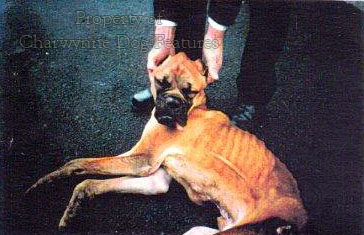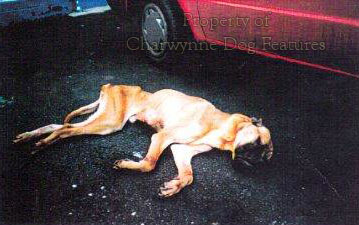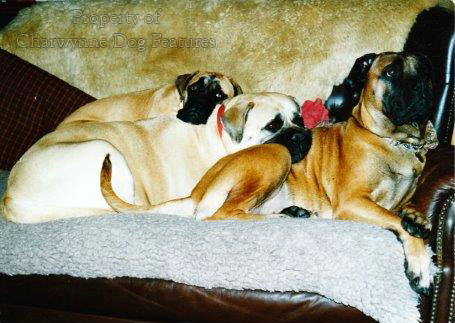257 Dying Dog That Wagged Its Tail
THE DYING DOG THAT WAGGED ITS TAIL
by David Hancock
 On the 21st of January 1997 a Bullmastiff was found on the roadside of the A.7 at Addiewell, West Lothian, Scotland. It had a severely overshot jaw deviating to the right, deformed ribs on its right side making an S-shaped curve, with a scar on its right front leg. It was a red fawn, about five years old; it was near death, weighing only 55lbs as opposed to an expected weight of around 125lbs. The dog had clearly been deliberately starved for months; its muscles were so wasted that it could not stand. There were signs that the dog had spent a protracted period lying on its side in its own excrement. There were badly infected sores on its hindquarters. Its bones were visibly protruding through its skin. Its toenails had curled round and grown into its pads. Despite its condition and its suffering over many months, the dying dog still tried to wag its tail at its rescuers.
On the 21st of January 1997 a Bullmastiff was found on the roadside of the A.7 at Addiewell, West Lothian, Scotland. It had a severely overshot jaw deviating to the right, deformed ribs on its right side making an S-shaped curve, with a scar on its right front leg. It was a red fawn, about five years old; it was near death, weighing only 55lbs as opposed to an expected weight of around 125lbs. The dog had clearly been deliberately starved for months; its muscles were so wasted that it could not stand. There were signs that the dog had spent a protracted period lying on its side in its own excrement. There were badly infected sores on its hindquarters. Its bones were visibly protruding through its skin. Its toenails had curled round and grown into its pads. Despite its condition and its suffering over many months, the dying dog still tried to wag its tail at its rescuers.
How strongly we felt when we read this horror story. For a moment, that is. Then we get on with our lives. We do nothing to prevent a recurrence. If, for example, we had a compulsory national registration scheme for our dogs, the perpetrator of this despicable, unforgivable act could be more easily traced. If we controlled breeding levels, we would minimise the risk of too many puppies being produced -- and then sold to quite unsuitable homes. But no, there is little support for such schemes. To become a judge in the show ring, you have to have bred lots of litters -- there's one incentive to overproduce. The Kennel Club will register anything with four legs and a tail -- there's another encouragement. It is right to feel angry about this dead Bullmastiff; it is wrong not to at least try to stop it happening again.
Just as a five generation pedigree tells you more about the breeder than the dog, so too can other KC documentation provide information on breeders. The Breed Records Supplements for example can reveal the pedigree breeders who are overproducing puppies and how the KC is quite content to register them. I am not aware of any formal research by rescue organisations into which breeders are mainly responsible for most dogs which head their way, but it would be a valuable exercise. When I talk to many breed fanciers about overbreeding, they usually know of the culprits, but say, with some sadness, who can stop them? More important to me here is: who wants to?
We used to be a nation famous for breeding high quality dogs; now we seem not to know the crucial difference between breeding dogs and producing puppies. Any fool with a bitch can produce puppies; to be a real dog-breeder you have to have skill, knowledge, patience and the single-minded pursuit of quality. The Kennel Club states that it is only prepared to register 19 litters from one breeder in a twelve month period. Their own records reveal however that eight or so breeders alone produced over 600 litters in a year, two of whom produced 150 litters each. But these breeders used over 40 different names and no affixes. No worthy canine club can permit such abuse to go on.
No one ever checks that the facts provided on the pedigree itself are actually true; dogs can be registered even if they are blind and deaf and the wrong colour for the breed standard. Such an 'open season' for cheats and dodgy breeders may well save money, sound democratic and value trust but it is gradually eroding our national reputation in this field. In time, I believe the Continentals, with their compulsory dog-registration schemes and their breed clubs, with their ambitions for quality, will leave us way behind. In our breed council system we have a surfeit of liaison and a total lack of teeth.
The opposition in Britain to a compulsory national dog-registration scheme usually comes from the sheer self-interest of individuals who put their bank balance first; they are dog-owners not dog-lovers. How on earth can we trace owners of abandoned dogs, ill-treated dogs or lost dogs without being able to identify the dog to start with? A dog-registration scheme is not intended to benefit humans but to protect dogs! How can irresponsible dog-ownership be countered if the dog-lobby itself reacts irresponsibly to well-intentioned proposals for such legislation? Facile arguments about whether tattooing is preferable to micro-chipping are ill-affordable diversions. The simple fact is that if we are serious and honourably-intentioned about improving dog protection in Britain, then we must insist, for the sake of dogs, on a national compulsory registration scheme.
On this question of dog identification, how does any dog show judge or steward know that the exhibit in front of them is actually the dog listed in the schedule? The Kennel Gazette regularly publishes details of disqualifications through 'wrong dog entered'. No doubt a plea of 'oversight' or 'faulty paperwork' is accepted. But it is far more widespread than admitted and not entirely due to human error. Without even random checks who can guarantee that the 'right dog' is being entered? In breeds with a uniform appearance like the Old English Sheepdog, the Samoyed, the Chow, the Pharaoh Hound, the Shiba Inu and the black and tan breeds, it is all too easy to enter the wrong dog. Win at all cost is not exactly unheard of in the dog game! The recent case of the Scottish Terrier owner, who got the wrong dog back from the grooming parlour and didn't realise it for several hours makes my point for me.
If we really were a nation of dog-lovers, we would be lobbying hard: for a compulsory dog registration scheme, for health clearances for breeding stock, for mandatory affixes and for puppy-quotas for pedigree dog breeders to be rigorously policed by the KC. It would help too if breed clubs had a more pro-active role in such matters, rather than eternally squabbling about committee appointments. The cry should be: fewer but better dogs and in better homes. Take just one example on the Continent to illustrate how dogs can be bred to better standards. Working gundogs there are regulated, monitored and subjected to advisory supervision by the breed clubs and their wardens. Dogs of minimal working ability cannot be bred from, or rather, control of registration prevents their offspring being registered. This is applied very strictly to stud dogs.
Stud dogs are more likely quantitively to pass on undesirable faults or diseases, some being used in Britain when still quite young and unproven from a health point of view. Just as important, in Continental working gundogs, most breed clubs there will only register pups sired by an approved stud dog and out of an approved bitch of minimum age, usually eighteen months. More important still, the frequency of litters a bitch can have is also controlled. Breed clubs only permit two litters per bitch per two calendar years; this means if the bitch is mated in two successive seasons, then the next two seasons must be missed. They have a breeding ban on dogs carrying inheritable defects and a grading system for the dog's conformation, with only stud dogs graded at least 'very good' being permitted to be used. They are trying to be responsible.
A Bullmastiff puppy costs around £500. It can cost in the region of £10 a week to feed such a substantial adult dog. Someone would have paid £500 for the dying Bullmastiff found by the roadside in Scotland. Anyone with any sense would have found out or soon realised that it costs another £500 every year to feed it. Only an idiot pays £500 for a dog and then starves it to death; a very cruel idiot, I should say. But is this cruel idiot living like a hermit in a remote spot, where such an atrocity can go undetected? No, the criminal responsible for this unspeakable act probably lives in the Lanark or Glasgow areas, with neighbours, relatives and friends. Somebody somewhere knew who did this and kept their head down.
But then, we all keep our heads down when the protection of dogs crops up. When the powers that be wage war on a breed of dog, only the Staffie people speak up. When we know of a breeder in our breed breeding twice a year from bitches and advertising the pups in unsuitable places, we look the other way. One Bullmastiff breeder has produced over 70 pups in under two years, but the breed clubs look the other way. When the KC registers 150 litters from two breeders, we do little to complain. If a dog registration scheme is going to hit our pockets, we complain vociferously. Even if such a scheme is for the benefit of dogs, we complain.
The dying Bullmastiff that wagged its tail at its rescuers just before it died sent a message to us all: Stop producing puppies which will go to undesirable homes. Unless all of us who care about dogs do something about this disgraceful unacceptable situation, this dog will have suffered in vain. Do something whilst you are still angry!